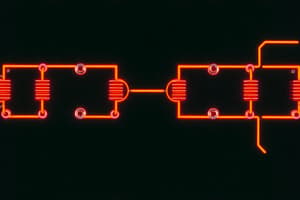Podcast
Questions and Answers
In a parallel circuit, how does the total resistance change as components are added?
In a parallel circuit, how does the total resistance change as components are added?
- Increases
- Decreases (correct)
- Remains the same
- Doubles
What happens to the total current in a series circuit with additional components?
What happens to the total current in a series circuit with additional components?
- Decreases
- Remains the same (correct)
- Varies unpredictably
- Increases
How is the power dissipated by each component related to the voltage squared in a series circuit?
How is the power dissipated by each component related to the voltage squared in a series circuit?
- Halved
- Proportional (correct)
- Unrelated
- Doubled
What is the relationship between current and power dissipation in a parallel circuit?
What is the relationship between current and power dissipation in a parallel circuit?
Which type of circuit is used in lighting systems to provide multiple lighting choices without a single point of failure?
Which type of circuit is used in lighting systems to provide multiple lighting choices without a single point of failure?
What is the main purpose of using series circuits in power distribution?
What is the main purpose of using series circuits in power distribution?
What happens to the total voltage in a series circuit?
What happens to the total voltage in a series circuit?
In a series circuit, what can be said about the current?
In a series circuit, what can be said about the current?
How does resistance behave in a series circuit?
How does resistance behave in a series circuit?
What relationship exists between power and voltage in a series circuit?
What relationship exists between power and voltage in a series circuit?
What happens to the total voltage in a parallel circuit?
What happens to the total voltage in a parallel circuit?
Describe how components are connected in a parallel circuit.
Describe how components are connected in a parallel circuit.
Flashcards are hidden until you start studying
Study Notes
Electricity and Circuits: Exploring Series and Parallel Connections
Electricity flows through conductive materials like wires, delivering energy from power sources to the devices we use in our daily lives. To control the behavior and performance of electrical circuits, we can connect components in different arrangements, such as series and parallel circuits.
Series Circuits
A series circuit is created when components are connected in a line, so that the current flows through each one in succession before returning to the power source. Here are a few key points about series circuits:
- The total voltage in a series circuit is the sum of the voltages of the individual components.
- The current in a series circuit is the same in all components.
- The resistance in a series circuit is the sum of the resistances of the individual components, meaning that the circuit's overall resistance increases as the number of components increases.
- The power dissipated by each component in a series circuit is proportional to the square of their individual voltages.
Parallel Circuits
A parallel circuit is created when components are connected directly across the power source, with multiple paths for the current to flow. Here are some important facts about parallel circuits:
- The total voltage in a parallel circuit is the same as the voltage of the power source.
- The current in a parallel circuit divides, with each component carrying a proportion of the total current based on their individual resistances.
- The resistance of a parallel circuit is less than that of the least resistive component.
- The power dissipated by each component in a parallel circuit is proportional to the square of their individual currents.
Comparison of Series and Parallel Circuits
The two main types of circuits have distinct characteristics that influence their performance and behavior.
- Series Circuits: Provide a fixed total voltage. The total resistance increases with additional components. The total current is the same in all components, but the power dissipated by each component is proportional to the voltage squared.
- Parallel Circuits: Provide a fixed total voltage. The total resistance decreases as components are added. The total current divides among the components, and the power dissipated by each component is proportional to the current squared.
Applications of Series and Parallel Circuits
A deep understanding of series and parallel circuits is essential for designing and analyzing electrical systems for various applications, including:
- Lighting systems, where series circuits are used to reduce the voltage at each bulb and parallel circuits are used to provide multiple lighting choices without a single point of failure.
- Power distribution, where series circuits are used to limit the current and parallel circuits are used to provide multiple paths for power distribution.
- Measurement and instrumentation, where series and parallel circuits are used to measure various electrical quantities.
- Batteries and renewable energy systems, where series and parallel connections are used to optimize voltage and energy storage capacity.
Whether you're an engineer, a student, or a curious individual, understanding series and parallel circuits is an essential part of learning about and working with electricity. With these fundamentals, you'll be able to analyze, design, and troubleshoot electrical systems with confidence.
Studying That Suits You
Use AI to generate personalized quizzes and flashcards to suit your learning preferences.




